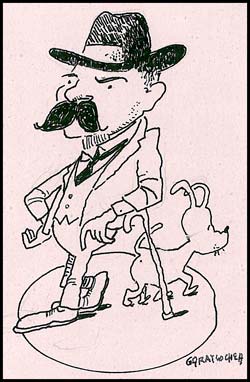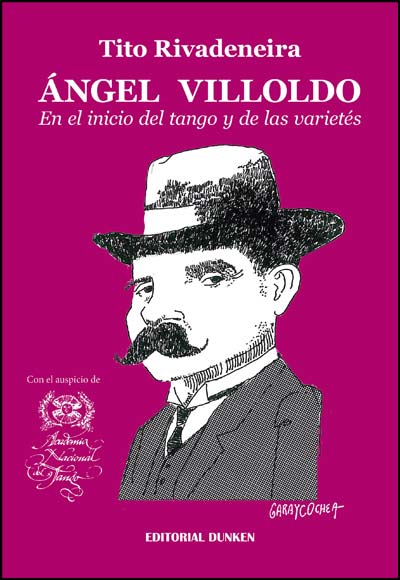By
The “compadrito-dancer”, but not the whorehouse, influenced Villoldo’s lyrics

t is usual to find in writings about Ángel Villoldo the conclusion that his turn- of-the-century tango lyrics were influenced by gaucho poetry, brothel texts and cuplé. José Gobello, in his Crónica General del Tango, says: «The Villoldo’s poetical and musical oeuvre are equally nurtured by ruffianesque poetry and cuplé». And after researching the influence of gaucho poetry, he adds: «Villoldo is like the urban payadores —specially, the most famous, Gabino Ezeiza and José Betinotti, because he practiced, at the same time, literature and singing».
 Sierra and Ferrer, on the other hand (Discepolín, 1965) do not mention the «ruffianesque» influence, and are decidedly inclined to the gaucho essence and, furthermore, minimize the role of «cuplé».
Sierra and Ferrer, on the other hand (Discepolín, 1965) do not mention the «ruffianesque» influence, and are decidedly inclined to the gaucho essence and, furthermore, minimize the role of «cuplé».
I adhere to the gaucho influence, but my thesis is that neither brothels nor cuplés had an impact on the lyrics of Villoldo’s popular tangos, save for “El Porteñito” (a brief introduction to whorehouse matters) and in “Cuidao con los cincuenta” (a cuplé-like writing). Next I shall talk about «brothel contents», putting aside the subject of the cuplé for another occasion.
The contents of brothel lyrics
José Gobello and Eduardo Stilman, in their book Las letras del tango de Villoldo a Borges (1966) state that: «And as poetry is man and his story, the one made by the murky inhabitants of the porteña river bank by the turn of the century was rude to the borders of obscenity, rarely without a heavy sexual intensity». But as for Villoldo, they explain: «The lyrics are joyful, talkative, sometimes rascally cunning, but never lewd» (I made the underlining).
Based on these conclusions, I made a research about these lyrics, beginning with two, widely known:
Quisiera ser canfinflero / para tener una mina / llenarla bien de bencina / y hacerle un hijo chofer.
And the other, regarded as a symbol of brothel lyrics (even though not the only one), in which the compadrito (pimp) is tied to his protegé enslaved to a brothel: “Dame la lata” (c.1888 anonymous):
Qué vida más arrastrada / la del pobre canfinflero /el lunes cobra las latas / el martes anda fulero.
Dame la lata que has escondido / ¿qué te pensás, bagayo
que yo soy filo? / ¡Dame la lata y a laburar! / Si no, la linda biaba te vas a ligar.
This lyrics is in the context of the brothel stuff: the ruffian arrives at the whorehouse, asks money to his dame and threatens her with a beating.
There is, on the other side, a book by Dr. Robert Lehmann-Nitsche, a German, (his pen name is Victor Borde) about brothel lyrics at the beginning of the twentieth century, and whom Gobello quotes: «The world of pimps, about which Robert Lehmann Nitsche left so many testimonies, is the one which, in general, most of the tango lyrics by Villoldo depict» (Crónica General del tango, p.64). My analysis leads me to a different conclusion.
The book mentioned is entitled Textos eróticos del Río de la Plata (first edition in German of 1923 and first one in Spanish in 1981, Librería Clásica, Buenos Aires). It is a linguistic essay on erotic texts of the River Plate regions, with records that date back to 1900. Under the title Texts in the original the German author groups together words of Poems, Comparisons, Phrases and Sayings, Proverbs, Trick Questions, Tales and Puzzles. The first grouping, Poems, is the one which has to be studied to evaluate if there is, or there is not, a relationship with Ángel’s lyrics, especially those sub-classified as Lupanarias (originated in brothels) (p.40).
The Lupanarias (or brothel songs) contain obscene lyrics, with words of heavy sexual meaning. In all of them we can see the explicit relationship pimp/prostitute, in general, physically placed inside the whorehouse. (Let us remember that Gobello explained that Villoldo did not use a lewd vocabulary, conclusion to which I adhere).
There is a poem, entitled “El vacán” (p. 64), with seven stanzas and in which only two stanzas may contain a certain insinuation to a Villoldian lyrics:
Cuando el vacán está en cana / la mina se peina rizos /no hay mina que no se espiante / cuando el vacán anda misho.
Qué vida triste y penosa / es la vida del canfinflero
los lunes cobra las latas / y los martes anda fulero.
 These two stanzas are, precisely, the ones that José Gobello quotes in his book. However, the two stanzas represent a 1,6 % of the total!. The other 119 stanzas (out of a total of 121) are the ones which really go deep into the brothel, with obscene language and scenes with physical threat to the whore by the pimp, which have nothing to do with the message of the lyrics of popular tangos and milongas (also recorded) by our composer.
These two stanzas are, precisely, the ones that José Gobello quotes in his book. However, the two stanzas represent a 1,6 % of the total!. The other 119 stanzas (out of a total of 121) are the ones which really go deep into the brothel, with obscene language and scenes with physical threat to the whore by the pimp, which have nothing to do with the message of the lyrics of popular tangos and milongas (also recorded) by our composer.
My conclusion is that, taking into account the research by Lehmann-Nitsche, either due to its line of reasoning or because of its vocabulary and spirit, the lyrics of the traditional tangos by Villoldo do not match up with the so-called brothel lyrics.
Yet other authors talk about Villoldo’s «concern about brothel matters» taking into consideration only one tango: “El Porteñito”, suggesting that all the other tangos of the composer followed that trend. And it is not so. I insist: save for “El Porteñito”, I found no tango lyrics by Villoldo with those direct, rude or brothel-connected contents; that was not his style; he rather «depicted caricatures» of the different facets of the compadritos, as we shall see in the next section.
On the other hand, whorehouse matters did have influence on the lyrics of his sassy tangos and milongas, like “Historia del Baldomero” or “Paseo de Julio”. But here we are talking about another line of recordings, which at the beginning were eight, all recorded for Columbia in 1910, under two mischievous stage names: Juan Techouna and Antonio Techotra. But I insist: these lyrics have nothing to do with those of his traditional tangos which the public used to sing.
If we take into consideration the grouping Épicas (p.72) in which Canfinfladas is included, with three poems, the first of them, may have «Villoldo’s style». There are no obscene words. It is about a tough guy who does not accept that others dare to threaten him and is ready to give his opponent a black eye, or maybe two. This lyrics may very well indicate an encounter in the street and does not allude either to a brothel or to the environment connected with it. The other two Poems, certainly have obscene words far removed from Ángel’s style.
The Compadritos’s facets, source of inspiration for Villoldo’s tangos
Andrés Carretero (El compadrito y el tango, 1999) warns us about the fact that there is not only one kind of compadrito, but several ones: bodyguard, pimp, cart driver, slaughterer, blacksmith, dancer (he pretends to be the best!) or simply «the morning worker».
Some of these facets were considered by Villoldo, and among them stands out the one of the compadrito/dancer (which brings him status), maybe the character most visited by Ángel in his main tangos. The Villoldian lyrics approach, mainly, the dancehall milieu, not the whorehouse. As Gobello says, page 66 (1964): «For all we know, Villoldo does not appear at the clandestine venues, like Mendizábal, Campoamor or Ponzio and even Bevilacqua. He sings at warehouses and variety theaters and at the famous Carpas de la Recoleta» (tents in La Recoleta).

Something that attracts my attention is, however, when he adds «his tangos and milongas will be written thinking of the compadritos who dance at the L’Operai —that is to say , the Societá L’Operaio Italiano, on 1374 Sarmiento Street—, in the Fratellanza, in Unione e Benevolenza and at the carnival balls held in theaters», not mentioning now, songs connected to brothels.
To have a thorough idea of the real significance of Ángel’s lyrics about compadritos, it is necessary to check the lyrics of his other tangos about these men, something that is not generally done.
I am speaking of his popular tangos like, for example, “Soy tremendo” (a Casanova compadrito, with two dames with whom he is flirting: one, on Esmeralda Street and the other, on Suipacha), “El más pesao” , “El torito”, “Cuerpo de alambre”, “El criollo más criollo”, “El terrible” and some others more (all alluding to the good dancer at the brothel, compadritos that are proud of having their dames by their side and in which lyrics do not show a pimp/whore relationship), or rather, “Calandria” (the cult to courage, in the style of Evaristo Carriego).
About this last facet, let us mention one of his archetypal milongas: “El carrero y el cochero”, a lyrics chosen by Borges to be included in his book El Compadrito, of 1945. Some authors regard this lyrics as comical. But that would be far removed from his spirit and message. In this lyrics, Ángel tries to portray «the cult to bravery» of two compadritos (one, coachman and the other, carriage driver). With that «see you later, pal» at the end, the honor of both guys is kept but, maybe, leaving «the thing» open, to the time when they would face each other on another street or other street corner.
More details in Ángel Villoldo. En el inicio del tango y Las varieties, by Tito Rivadeneira, Ed. Dunken, 2014. email: titorivadeneira@gmail.com